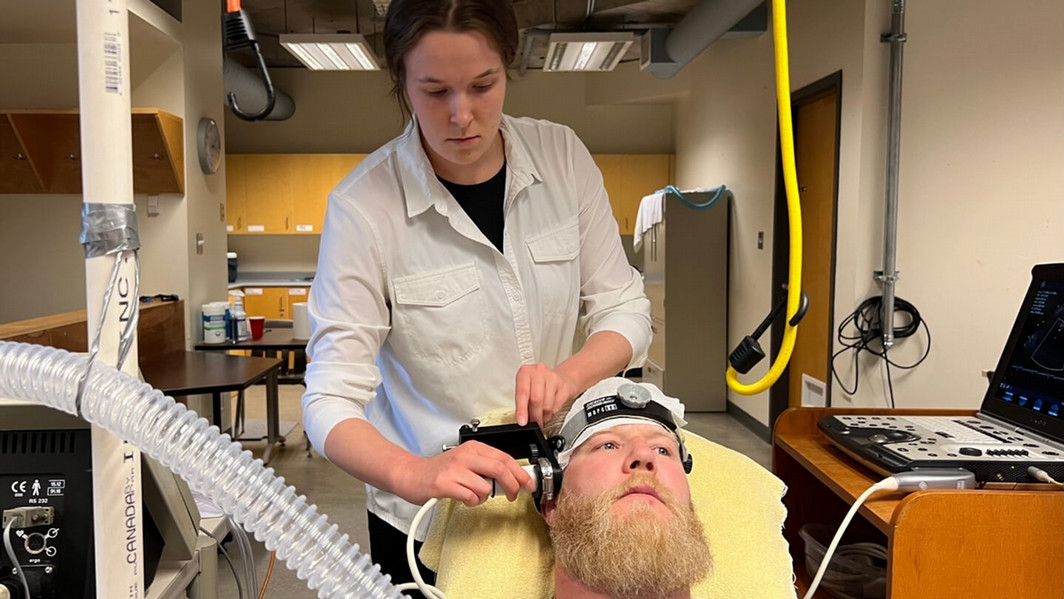What do brain health, lifestyle and sex hormones have in common?
December 15, 2023

Dr. Kurt Smith is a cerebrovascular physiologist in the School of Exercise Science and Physical Health Education (EPHE) at UVic. He oversees the Cerebrovascular Health Exercise and Environmental Research Sciences (CHEERS) Laboratory and specializes as an exercise physiologist, using physical exercise as a way to investigate brain health.
Tabitha Craig is a former varsity swimmer and second-year Ph.D. student in EPHE, working with Kurt in the CHEERS Lab. She completed an undergraduate degree in Kinesiology at UVic before continuing her graduate studies and fast-tracking straight into her Ph.D. program. Tabitha’s research is focused on investigating how sex hormone fluctuations over the menstrual cycle impact brain function.
We visited the CHEERS lab to learn more about Kurt and Tabitha's work.
What do you do in the CHEERS lab?
Kurt: We study brain health. Specifically, we look at ways we can stress the brain to gain insight into potential causes of pathological cerebrovascular aging. We do this using exercise or environmental manipulations, which stimulate brain blood flow and allow us to measure important markers of brain health.
In the lab, we conduct exercise-based experiments and do blood analysis to explore the mechanisms of what is “healthy” vascular aging. We try and develop new techniques using exercise, oxygen or CO2 to stimulate the brain and observe what changes occur.
What is your primary research question?
Kurt: We’re trying to get a better understanding of the effects of sex hormones on the blood vessels in our brain. Most of the research that has been done in this area has looked at the impact of sex hormones on blood vessels in the arm – but we know that the brain responds very differently than the arm. Plus, it’s only been in the last five years that researchers have begun to include female subjects in their studies. Within that, very few have accounted for how the menstrual cycle may impact hormone levels across a month. They try to standardize our tests to best account for potential fluctuations in sex hormones.
More data is now coming out and shows that women frequently present very differently from men following heart attacks, which is why they're often underdiagnosed. There is some evidence that women have a higher prevalence of stroke as well. But we don't yet fully understand how someone’s lifetime spent before say, menopause, could be laying the groundwork for a heart attack or stroke, or perhaps preventing or delaying these outcomes. We hope this research will help us better understand risk factors and preventative measures, as well as identify high-risk individuals earlier on.
Can you tell us about your current project?
Tabitha: My current project is looking at subjects all across the gender spectrum between the ages of 19 to 40. We use exercise as a way to increase CO2 and measure responses in the body. For example, we submerge an arm in an ice-cold bucket of water and measure changes in the subject’s blood pressure, heart rate, internal carotid artery and middle cerebral artery. We also collect blood draws from each participant during most sessions.
For our participants who menstruate, we take the measurements at four different points across their monthly menstrual cycle as hormone levels fluctuate. For participants who don’t menstruate, the measurements can be taken over a few days.
Once we've collected all the data, we’ll analyze to determine each subject’s level of estrogen, progesterone, testosterone and molecular stimulating hormone. We'll be looking to see whether there's any impact depending on factors like someone’s method of hormonal birth control. We can go back to assess whether it has a higher dose of estrogen or progesterone and see whether there is a correlation.
How can people get involved with your current study?
Tabitha: We're looking for healthy individuals all across the gender spectrum between the ages of 19 and 40, who are interested in learning more about lifestyle and brain health. They come in for a series of visits over a few weeks that can be 30 minutes to 2 hours in length.
Female participants come in six times: once for screening, once for exercise, and then a few subsequent visits for CO2, blood draws and a cold pressure test throughout their menstrual cycle. For male participants, there are four visits: one for screening, one for exercise, and then two for the other tests. In theory, a male participant can be done over four days. All our participants are compensated with coffee cards and more, plus they get to see some pretty cool scans of their brains.
Kurt: The fun part for me is always the science and collecting the data. My students are actively getting to see the importance of ultrasound and how it can be used to measure markers of vascular health. I think sometimes my students are a little nervous because the techniques we use seem pretty new. Mostly, we don't see these kinds of techniques included in undergraduate studies, but I'm trying to change that so there's more hands-on learning. I always say: the CHEERS lab door is always open.
Questions? Email CHEERSlabUVic@gmail.com.
